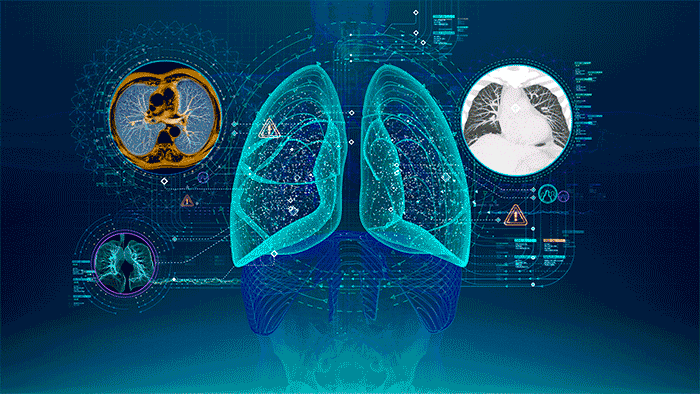
APPOINTMENT WITH THE I-DOCTOR
Radiologists, the doctors who interpret X-rays and other medical scans, can look at hundreds of images a day. Crunched for time, they sometimes flag as urgent anything that looks even a little out of the ordinary — which can clog the pipeline and slow diagnosis of serious problems such as collapsed lung, aka pneumothorax. But now a global collaboration of hospitals, together with GE Healthcare, is giving docs a hand. Their solution is an algorithm trained to read lung X-rays in a flash and help prioritize critical cases.
How to train your algorithm: The team trained the app by showing it thousands of X-ray images and teaching it to identify the specific problem in each, “similar to the way you teach a kid to recognize things,” said Keith Bigelow, senior vice president of analytics and AI at GE Healthcare. “Every time you see a photo of a cat, you point and say ‘cat.’ It’s the same process as training a deep-learning algorithm.” The software was developed on Edison, a digital platform built by GE Healthcare, and comes inside the company’s mobile X-ray machine called Optima XR240amx with Critical Care Suite. It’s the first X-ray scanner with AI embedded in the system, but GE Healthcare needs to obtain Food and Drug Administration clearance before the algorithms can be used in hospitals. The submission, known as 510(k), is pending, and the tech is not yet available for sale.
In addition to lung scans, AI is also improving MRI brain imaging. Read more here.
PEDAL TO THE METAL
Last week, GE announced that it would supply two gas turbines to power a large metals smelter operated by Korea Zinc. The combined-cycle power plant in Onsan, south of Seoul, will generate more than 270 megawatts. It will use liquefied natural gas, or LNG, as fuel.
A pot of gold: Korea Zinc makes 18 different nonferrous metals, including zinc, lead, gold, silver and copper, as well as rare metals like indium. Smelters need access to reliable power, and the turbines, which GE calls 6F.03, will allow the metals producer to generate its own electrons. “Our gas turbines provide high efficiency with durability and flexibility that will enhance Korea Zinc’s productivity,” said Woonsik Ha, GE Power executive leader in Korea. There are currently 89 GE steam turbines and 106 gas turbines operating in Korea. In total, the company’s technology can produce 56 gigawatts, or about 47 percent of Korea’s installed capacity.
FANTASTIC VOYAGE
In space, no one can hear you scream — but they can pick up the data you transmit across the depthless void, which is how NASA learned recently that its Voyager 2 space probe had slipped out of the solar system and entered interstellar space, some 11 billion miles away. It’s only the second human-made craft to log such a distance; the first was its sibling, Voyager 1, which took a straighter path and got there in 2012. Forty-one years after their launch, both probes are still drawing power from a GE-made piece of technology called a radioisotope thermoelectric generator. The company also helped design the Voyagers’ computer command subsystems, flight-control processors and other tech.
Living on borrowed space-time: The Voyagers launched in 1977 and were expected to last only a few years. “NASA considered everything past the Saturn encounter a bonus,” said Howard Butler, who ran GE’s Aerospace Electronic Systems department and managed GE’s development of the command computers for Voyager 2. GE has also contributed tech to many other space probes and satellites that are less far flung, including the record-breaking Landsat 5 and two of the biggest spy satellites ever built.
The Voyagers’ next stop is someplace called the Oort cloud. Want to watch it happen? Set an alarm on your phone — for 300 years from now. Or just read more here.
— VIDEO OF THE WEEK —
https://www.facebook.com/GE/videos/2151147911608791/
— QUOTE OF THE DAY —
“This is a very exciting time to be in this space. Our compute capabilities have caught up with our conceptual idea of how to make AI come to life.”
— Dr. Rachael Callcut, associate professor of surgery at the University of California, San Francisco Medical Center and director of data science at UCSF’s Center for Digital Health Innovation
Quote: GE Reports. Image: Getty Images.
ENJOY THIS NEWSLETTER?
Please send it to your friends and let them know they can subscribe here.





